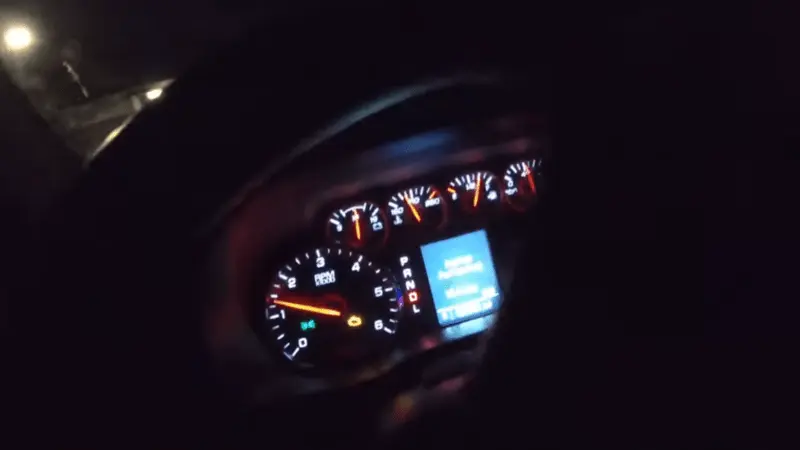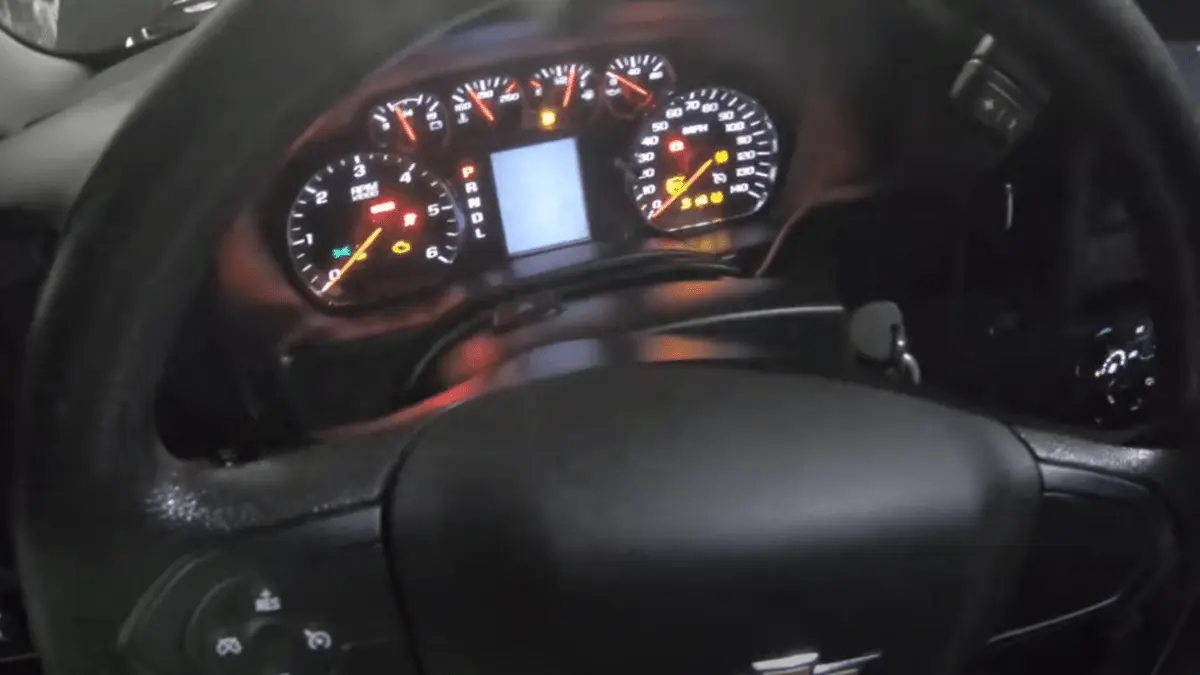When your Chevy Silverado’s check engine light starts flashing during acceleration, it’s not just a minor annoyance—it’s a warning sign that something serious is afoot under the hood. In our blog post, we delve into this common and concerning issue, exploring the potential causes behind a flashing check engine light during acceleration.
From ignition system problems to exhaust concerns, we’ll provide insights into what might be going wrong with your Silverado. Understanding these issues is the first step in diagnosing and addressing the problem, preventing further damage and costly repairs. Don’t let a flashing check engine light slow you down; let’s uncover the solutions together.
RELATED: Chevy Silverado Check Engine Light Flashing Then Stops
Causes of Chevy Silverado Check Engine Light Flashing When Accelerating

If your Chevy Silverado’s check engine light flashes when you accelerate, it indicates something is amiss with your vehicle’s engine or related systems. Ignoring a flashing check engine light can lead to more severe and costly problems. Let’s explore six potential causes for this issue:
1. Ignition System Issues:
Problems within the ignition system can trigger a flashing check engine light when accelerating. This may include issues with spark plugs, ignition coils, or spark plug wires. When these components malfunction, they can lead to misfires, which can cause the check engine light to flash. A misfire can be due to worn-out spark plugs or damaged ignition components, and addressing these issues promptly can prevent engine damage.
2. Vacuum Leak:
A vacuum leak in the engine’s intake manifold or vacuum hoses can cause the check engine light to flash during acceleration. When there’s an unintended opening in the vacuum system, it disrupts the air-fuel mixture, leading to poor combustion and engine misfires. Diagnosing and repairing vacuum leaks are essential to restore the engine’s efficiency and eliminate the flashing warning.
3. Sensor Issues with the Engine:
Modern vehicles rely on various sensors to monitor engine performance. If a sensor, such as the Mass Air Flow (MAF) or the oxygen (O2) sensor, malfunctions, it can lead to an incorrect air-fuel mixture. This can result in a flashing check engine light as the engine control unit (ECU) attempts to compensate for the sensor’s inaccurate readings. Replacing or repairing the faulty sensor is necessary to address the issue.
4. Fuel Supply System Problems:
Issues in the fuel supply system can also trigger a flashing check engine light. Fuel-related problems may include a clogged fuel injector, a failing fuel pump, or insufficient fuel pressure. These issues can result in poor fuel delivery, leading to misfires and a flashing warning light. A professional inspection of the fuel system is crucial to identify and fix the problem.
5. Exhaust System Concerns:
Problems within the exhaust system, such as a clogged catalytic converter, can lead to a flashing check engine light. A clogged catalytic converter restricts the flow of exhaust gases, causing backpressure that can lead to misfires. Additionally, exhaust leaks can disrupt engine performance, triggering the warning light.
6. Overheating Engine:
If your engine is overheating when accelerating, the ECU may flash the check engine light as a warning. Overheating can result from a malfunctioning thermostat, a leaking coolant system, or a faulty water pump. Overheating can cause severe engine damage, so it’s crucial to address the cooling system problems promptly.
How To Fix The Issue?
Addressing a flashing check engine light in your Chevy Silverado during acceleration requires a systematic approach to diagnosing and resolving the underlying issues. Here’s how to fix the problem:
Diagnostic Trouble Code (DTC) Scan:
Start by having a professional mechanic or an auto parts store perform a DTC scan. This scan retrieves error codes stored in the engine control unit (ECU) that can pinpoint the specific issue causing the flashing check engine light. These codes provide valuable information to guide the repair process.
Inspect and Repair Ignition System Issues:
If the DTC scan reveals ignition system problems, inspect and repair components like spark plugs, ignition coils, and spark plug wires. Worn-out or damaged spark plugs can lead to misfires. Replacing these components may resolve the issue. Additionally, ensure proper spark plug gap settings.
Address Vacuum Leaks:
Vacuum leaks can disrupt the air-fuel mixture, leading to misfires. Carefully inspect vacuum hoses, the intake manifold gasket, and other components. Replace any damaged or deteriorated parts and reseal connections to eliminate leaks.
Repair or Replace Faulty Sensors:
Malfunctioning sensors, such as the Mass Air Flow (MAF) or oxygen (O2) sensor, can be diagnosed using the DTC scan. When identified, replace or repair these sensors to ensure accurate data for the ECU. Proper sensor function is crucial for maintaining the correct air-fuel mixture.
Inspect and Repair Fuel Supply System:
Fuel-related issues, such as clogged fuel injectors, a failing fuel pump, or low fuel pressure, require a thorough inspection. Clean or replace clogged fuel injectors, ensure the fuel pump operates correctly, and verify the fuel pressure meets manufacturer specifications.
Examine and Address Exhaust System Problems:
If a clogged catalytic converter or exhaust leaks are identified as the issue, address them promptly. Replacing a clogged catalytic converter and repairing exhaust leaks will help restore proper exhaust gas flow and prevent misfires.
Cooling System Maintenance:
If engine overheating is the cause of the flashing, check the engine light and the cooling system components. Inspect the thermostat, radiator, coolant levels, and related parts. Repair or replace any components that are not functioning correctly to prevent overheating issues.
Professional Assistance:
Complex issues, such as sensor malfunctions or major exhaust and engine problems, may require professional expertise. In such cases, consult a certified mechanic who can conduct a thorough inspection and perform the necessary repairs.
Clearing Error Codes:
After addressing the underlying issues, clear the error codes stored in the ECU using the same diagnostic tool. This step is essential to reset the check engine light and verify that the issue has been resolved.
How Much Does It Cost To Check The Engine Light?
The cost of checking the engine light can vary depending on where you take your vehicle and the specific diagnostic services offered. Typically, the price range for diagnosing and testing a “check engine” warning light falls between $85 and $110. This cost covers the labor and equipment needed to retrieve error codes from the vehicle’s onboard computer, which provides information about the issue triggering the warning light.
However, it’s worth noting that some automotive service centers, like Stevinson Chevrolet, may offer complimentary multi-point checks and diagnostics for your check engine light. These services are often provided at no additional cost, which can be an excellent option for those looking to determine the cause of the warning light without incurring extra expenses.
Error Codes Of Check Engine Light Flashing
- P0300 – Random/Multiple Cylinder Misfire: This code indicates that random misfires occur across multiple cylinders. It’s a broad code that suggests a widespread issue with the ignition system, fuel delivery, or engine timing.
- P0301, P0302, P0303, etc. – Cylinder Specific Misfire: These codes correspond to specific cylinders. For example, P0301 indicates a misfire in cylinder 1. These codes pinpoint which cylinder is experiencing a misfire, making it easier to diagnose and repair.
- P0304 – Misfire Detected in Cylinder 4: Similar to the previous example, P0304 identifies a misfire in cylinder 4. This allows for more precise troubleshooting.
- P0305 – Cylinder 5 Misfire Detected: This code indicates a misfire in cylinder 5. It helps identify the problematic cylinder.
- P0420 – Catalyst System Efficiency Below Threshold: While not a misfire code, P0420 is often triggered by misfires. It suggests that the catalytic converter is not functioning as efficiently as it should due to excessive unburned fuel from misfires.
- P0171 – System Too Lean (Bank 1): A flashing check engine light can also be related to a lean air-fuel mixture. P0171 indicates too much air and insufficient fuel in the mixture on bank 1, which can lead to misfires.
- P0174 – System Too Lean (Bank 2): This code is similar to P0171 but pertains to Bank 2. It signals a lean air-fuel mixture in the cylinders on this bank.
- P0306 – Cylinder 6 Misfire Detected: Like previous cylinder-specific codes, P0306 indicates a misfire in cylinder 6.
- P0307, P0308, etc. – Misfire Codes for Other Cylinders: These codes correspond to specific cylinders, allowing for the identification of misfires in each one.
FAQs
1. What Should I Do If My Chevy Silverado’s Check Engine Light Flashes During Acceleration?
A flashing check engine light indicates a severe issue. Immediately reduce acceleration, avoid heavy loads, and have your vehicle inspected by a professional mechanic.
2. Can I Continue Driving With A Flashing Check Engine Light?
It’s not advisable to drive with a flashing check engine light. Continuing to drive can cause further damage to your engine and emission systems.
3. What Are The Common Causes Of A Flashing Check Engine Light In A Chevy Silverado?
Common causes include ignition system issues, vacuum leaks, sensor malfunctions, fuel supply problems, exhaust concerns, and overheating.
4. How Can I Diagnose And Fix The Issue Of A Flashing Check Engine Light In My Silverado?
Diagnosing and fixing the problem involves a systematic approach, including a diagnostic trouble code (DTC) scan, inspection and repair of relevant components, and addressing the root cause of the issue.
5. Why Is It Essential To Address A Flashing Check Engine Light Promptly?
Ignoring a flashing check engine light can lead to severe engine damage and expensive repairs. Prompt attention and diagnosis are crucial to prevent further complications.
Final Words
Your Chevy Silverado’s check engine light is more than just a dashboard indicator—it’s your vehicle’s voice, alerting you to potential engine issues. When it starts flashing during acceleration, it’s sounding the alarm for immediate attention. As we’ve explored in this post, the causes of this issue can range from minor misfires to severe exhaust and cooling system concerns. The key is not to ignore it but to diagnose and resolve the issue swiftly. The consequences of neglecting a flashing check engine light can be costly and damaging. So, if you find your Silverado’s engine light flashing, don’t hesitate—take the necessary steps to maintain your vehicle’s performance and reliability.

Eric L. Friedman is a car expert who has worked on Chevy and GMC trucks for over 10 years. He started AutoYolo to help people fix their own cars. On the blog, he shares easy tips, step-by-step guides, and repair advice to make car problems less stressful and more affordable.

